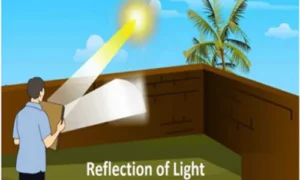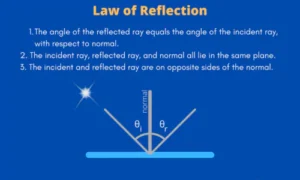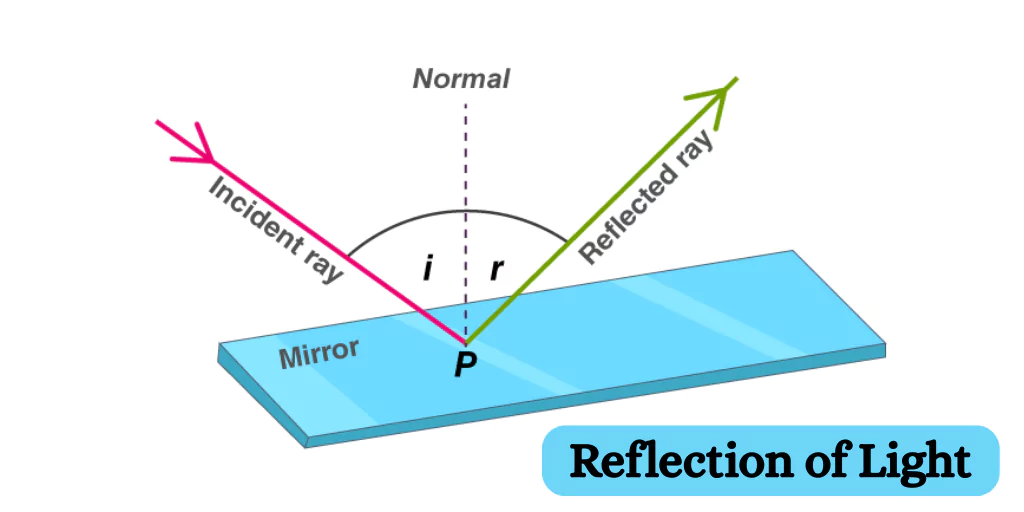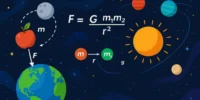Recently updated on August 20th, 2025 at 03:48 pm
Reflection of light is not only a simple everyday occurrence but also a cornerstone of optics that explains how images are formed. Without reflection, we would not have mirrors, cameras, periscopes, telescopes, or even the ability to view objects. In this article, we’ll explore what reflection of light is, explain the laws of reflection, discuss its types, and highlight real-life examples that make this concept easy to understand.
What does it mean to reflect light?

Reflection of light happens when light rays strike a surface and bounce back into the same medium. This phenomenon allows us to observe objects that do not emit light. Smooth surfaces, such as mirrors, reflect the majority of light, allowing us to see clearly.
Laws of Reflection

The reflection of it is governed by two fundamental rules.
1. The Angle of Incidence is Equal to the Angle of Reflection:
That is, the angle at which the light hits a surface (angle of incidence) is equal to the angle at which it reflects away (angle of reflection).
2. The Incident Ray, Reflected Ray, and Normal Lie in the Same Plane:
These three always lie in the same plane at the point of incidence.
Types of Reflection

There are two main types of reflection based on the nature of the reflecting surface:
1. Regular (Specular) Reflection
- Occurs on smooth and polished surfaces like mirrors.
- Reflected rays are parallel.
- Produces clear and sharp images.
2. Diffuse (Irregular) Reflection
- Happens on rough or uneven surfaces.
- Reflected rays scatter in different directions.
- No clear image is formed, but the surface is still visible.
Important Terms in Reflection
- Incident Ray: The incoming ray of light that strikes the surface.
- Reflected Ray: A ray that rebounds off a reflective surface.
- Normal: A perpendicular line drawn where the incident ray hits the surface.
- Angle of Incidence: The angle formed between the incident ray and the normal.
- Angle of Reflection: The angle formed between the reflected beam and the normal.
Real-Life Applications of Reflection

Reflection is used in many devices and daily life scenarios, such as:
- Mirrors: For grooming and decoration.
- Periscopes: Used in submarines to see above water.
- Cameras and Optical Instruments: Use internal mirrors for image capturing.
- Reflectors: Found on bicycles and roads to reflect light to drivers at night.
- Solar Cookers: Use reflective surfaces to focus sunlight for cooking.
Interesting Facts about Reflection
1. Animals such as cats and deer have reflecting coatings in their eyes that allow them to see better in the dark.
2. Retroreflectors are specific materials that return light to its source, regardless of the incident angle.
Conclusion
Reflection of light is more than just a concept in physics – it’s a part of our everyday experience. From mirrors to modern technology, understanding reflection helps us design better tools and interpret the world around us more clearly. As you explore more in physics, reflection serves as a stepping stone to more advanced topics like refraction, dispersion, and optics.
FAQs on Reflection of Light
Q1: What is the main difference between regular and diffuse reflection?
A: Regular reflection forms clear images on smooth surfaces, while diffuse reflection does not form images due to scattering on rough surfaces.
Q2: Why can we see ourselves in a mirror but not on paper?
A: A mirror has a smooth surface that reflects light regularly, whereas paper causes diffuse reflection, which doesn’t produce a clear image.
Q3: What is the angle of incidence if the angle of reflection is 40°?
A: According to the law of reflection, the angle of incidence is also 40°.






